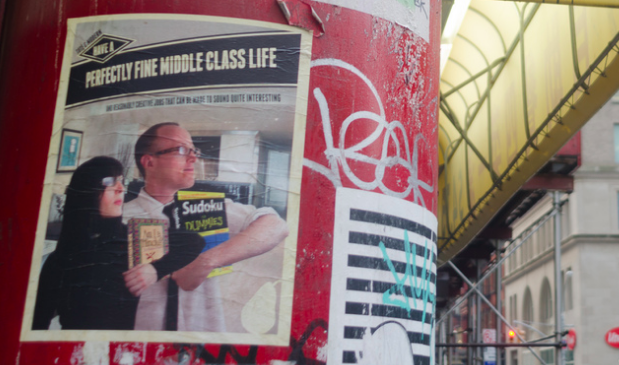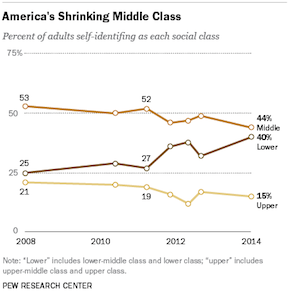Fewer Americans Identify As Middle Class Following The Great Recession Image courtesy of From the Pew Research Center's study "America's Shrinking Middle Class"
Though the recession may be in our rearview mirror, the Associated Press reports that the number of Americans who identify as middle class has fallen.
A recent Pew Research Center report found that only 44% of Americans identify themselves as middle class, while nearly 53% identified as middle class when the recession began in 2008.
It’s not surprising then that the number of American’s identifying as lower or lower-middle class rose by 15% from 25% in 2008 to 40% this year.
There are a number of factors, including employment, that could have caused such a significant change in middle class identification, experts say.
The elimination of 8.7 million jobs, many of which were middle-income positions, left a “hollowed-out” workforce. The loss of those jobs meant many middle class consumers took lower paying jobs and were unable to maintain their former lifestyles.
Other factor experts say affects the way American’s identify with class structure is home ownership, the recession did lead to the mortgage crisis, after all.
Both of those changes factored into how Rob, from Florida, identifies himself in the class structure.
He went from working for Boeing in 2011 to stocking the produce section of a supermarket. Rob and his wife went from a three-bedroom home in the suburbs to an apartment.
“It’s definitely been a step back,” he says of his economic situation.
Another factor for consumers is their ability to help their children pay for college.
Instead of saving for their child’s college fund many Americans have found themselves still paying off their own college debt.
Kristina, from Michigan, once considered herself firmly engrained in the middle class. But when she was laid off from her teaching job her family’s household income was cut in half.
With two master’s degrees and less income, Kristina says she has “lots and lots of debt” and isn’t prepared to help her children pay for college.
“Now we’re on the upper end of lower class,” she tells the AP.
Even those who long identified with the middle class and paid their dues with years in the workforce before retiring now feel the essence of middle class slipping away.
Richard, a former postal employee from Wisconsin, says his social structure has gone down a notch to lower-middle class since high gas prices and the rising cost of living have poked holes in his retirement savings.
Of course the definition of middle class changes based on a consumer’s location, the AP reports.
Those with what could be considered upper or upper-middle class incomes often identify as middle class when living in urban areas where the cost of living is higher.
A National Opinion Research Center survey conducted in 2012 found that 8.4% of consumers said they consider themselves lower class. The percentage was the largest the survey has ever received.
And that’s unusual since class identification is the most stable measure of the survey, Tom Smith, director of the NORC, says.
Still, experts say the increase in Americans who feel they’ve fallen below middle class is significant.
Today, people think it’s more difficult to achieve the American dream than thought so several decades ago, Mark Rank, a sociology professor at Washington University in St. Louis, tell the AP.
More Americans see middle class status slipping [The Washington Post]
Want more consumer news? Visit our parent organization, Consumer Reports, for the latest on scams, recalls, and other consumer issues.



